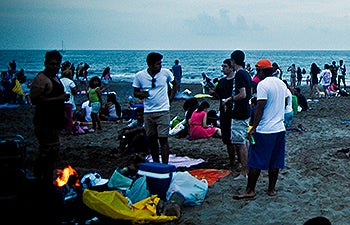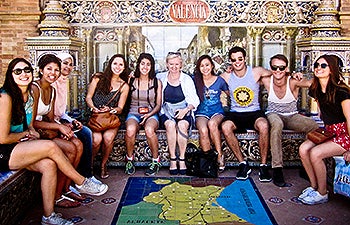A Wish Granted
Bonfires flickered like candlelights dotting the Spanish shores of Malvarrosa Beach.
Thousands of Valencians were gathered at the beach to celebrate La Noche de San Juan, the night welcoming the summer season. Just a few days earlier, I had learned the event’s traditions in my “Immigration in Spain” course directed by Marianna Chodorowska-Pilch, associate professor (teaching) of Spanish.
Jump over a bonfire thrice, jump in the ocean nine times with my back to the horizon, write down a wish on a piece of paper then burn it in the bonfire. After we fulfilled these necessary components, I turned to Dr. Chodorowska-Pilch with a huge smile.
“Ahora realmente somos valencianos, ¿eh?” (“Now we really are Valencians, huh?”) In participating in this Spanish ritual, I truly felt the cultural immersion I had been seeking by studying abroad with USC Dornsife.

Celebrated since ancient times on the shortest day in Valencia, Spain, La Noche de San Juan includes rituals meant to predict good luck. Photo by Engie Salama.
As a global health major at the Keck School of Medicine of USC and USC Dornsife Spanish minor, I found the course in Spain to be an excellent crossover between international relations — a component of my major — and an opportunity to strengthen my language skills.
One area of study is public health — a subject with heightened importance considering epidemics such as the Ebola virus. Indeed, diseases cross country borders as easily as people do. Our visits to the Valencia Health Centre, the Islamic Cultural Center in Valencia, the Catholic Charity Organization (Cáritas), and the Spanish Commission for Refugee Aid, were all incredibly informative and interesting excursions.
Not only did I learn about the political environment that dictates policies on immigration from my classwork and lectures, I was able to see the non-governmental organizations working on the ground. We also saw professionals who strive to support immigrants in the legal, medical and social capacities.
In addition to our daily lectures from the University of Madrid’s Dr. Juan Antonio Brasas, we enjoyed a Spanish culture class twice weekly. Whether learning common slang or how to cook delicious Valencian paella, the class was tremendously fun, interesting and engaging. The coursework, completely in Spanish, was understandable yet challenging. The professor and cultural instructor answered our questions and explained difficult phrases and concepts.

Engie Salama, a senior at USC Dornsife and Keck School of Medicine of USC, stands in front of the cathedral in Toledo. Photo by Marianna Chodorowska-Pilch.
The course culminated in a 10-page paper and in-class presentation discussing one particular immigrant group. I emerged from the course proud of my first full-length academic paper in Spanish, and with a greater understanding of Arab immigrants — specifically the Moroccan population — and their role in Spanish society.
We also experienced amazing weekend trips planned by Dr. Chodorowska-Pilch. She did an amazing job arranging our time in Toledo and Seville, both gorgeous cities in the region of Andalusia. My favorite part was visiting the religious buildings influenced by “las tres culturas,” (“the three cultures”) and seeing the Islamic, Christian and Jewish traditions co-existing in harmony during the time of the Andalusian Empire.
The churches in the style of mudejar architecture, the incredible altars within the cathedrals, and the ancient synagogues struck a chord with my love for interfaith. As an active participant in the USC Office of Religious Life, and president of the USC Interfaith Council, I now often find myself integrating my experiences in Toledo and Seville in our groups’ discussions of various interfaith topics.
This program connected not only to my cultural and academic interests while in Spain, but resonated with my personal love for interfaith and involvement at USC, more than 6,000 miles away!

Marianna Chodorowska-Pilch sits in Valencia, Spain, surrounded by undergraduates taking her overseas course examining immigration issues this past summer. Photo courtesy of Marianna Chodorowska-Pilch.
Ultimately, the Valencia Summer Program improved my Spanish, expanded my understanding of immigration in Spain and provided an invaluable cultural experience. Without a doubt, this was among the best classes I have taken at USC. I learned to understand immigration in a different language and from various disciplinary perspectives.
Living among Spanish college students, cheering for the Spanish team during the World Cup and adopting a new cultural framework for the duration of my stay allowed me to truly feel like a dynamic, well-versed and culturally immersed study-abroad student.
That night on Malvarrosa Beach, during La Noche de San Juan, I had wished for happiness, intellectual growth and cultural understanding. With the USC Valencia program, my wish was granted a thousand times over.
Senior Engie Salama teaches organic chemistry in supplemental instruction at USC Dornsife and is mentorship coordinator of the Keck Undergraduate Student Ambassadors. She studies the interplay between religion and health, intellectual property rights and pharmaceutical patent law. Currently applying for PharmD programs, she plans to work in international health focusing on access to medicines.